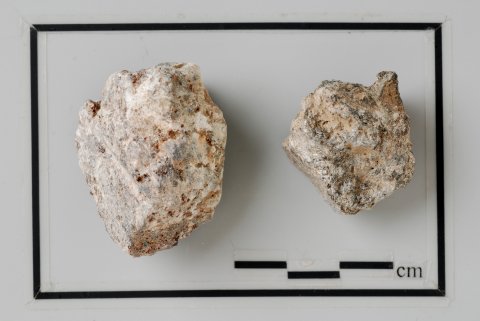The Stratton Mill Creek site was a seasonally reoccupied camp with the main periods of use during the Late Archaic (1950-1860 B.C. and 1850-1770 B.C.; 3650-3520 B.C.; 3260-3250 B.C. and 3100-2910 B.C.), Transitional (1500-1400 B.C.; 1773 - 1627 B.C. and 1865 - 1849 B.C.), and Early Woodland (174-19 B.C. and 13-0 B.C.). The site was also used sporadically during the Middle Archaic (6262-6087 B.C. and 6345-6312 B.C.) and historic (A.D. 1660-1890 and A.D. 1910-1950) periods. The site's chronology was determined using soil stratigraphy, radiometric dates, dendrochronology, and diagnostic material culture (points, steatite).
Soil Stratigraphy
Site stratigraphy was complex and showed up to four deep cultural (material culture-bearing) soil layers (A horizons, or organic soils indicative of stable surfaces) below the plow zone (Ap horizon), depending on topographic location. The terrace consisted of a plow zone with cultural material dating to the Middle Archaic, Late Archaic, Transitional, and Historic periods. On the flood plain were the deeply buried deposits. The most recent (the Ab1 horizon) dates to the Early Woodland period; the Ab2 horizon dates to the Transitional period; the Ab3 and Ab4 horizons date to the Late Archaic period.
Radiometric Dates
Archaeologists obtained nine radiometric dates. All are accelerator mass spectrometry (AMS) dates. Dates were obtained on carbonized material or nutshell from features or buried A horizons. Calibrated ranges for dates are associated with the Middle Archaic, Late Archaic, Transitional, Early Woodland, and Historic periods.
Two dates from two features associated with the Ab4 horizon returned dates falling within the Late Archaic. Feature 4 dates to 3650-3520 B.C. (calibrated two sigma) and Feature 5 to 3260-3250 B.C. and 3100-2910 B.C. (calibrated two sigma).
An organic sediment sample from the Ab3 horizon returned a calibrated two sigma date range of 1950-1860 and 1850-1770 B.C., also falling within the Late Archaic.
Organic sediment from the Ab2 horizon returned a date falling within the Transitional period (calibrated two sigma 1500-1400 B.C.). A date on nutshell from Feature 2 (Ap horizon, terrace) returned a date of 1773-1627 B.C. and 1865-1849 B.C. (calibrated two sigma), falling within the early Transitional period.
The Early Woodland date (174-19 B.C. and 13-0 B.C., calibrated two sigma) was obtained from Feature 12, associated with the Ab1 horizon.
A date from Feature 15/18 falls within the Historic period and returned the following calibrated two sigma date: A.D. 1660-1890 and A.D. 1910-1950. A second date from Feature 15/18 on nutshell returned a date with a calibrated two sigma range of 6262-6087 B.C. and 6345-6312 B.C., which falls within the very early portion of the Middle Archaic (or late Early Archaic) period.
Dendrochronology Dates
Three charcoal samples were submitted to the Cornell Tree-Ring Lab, Cornell University, Ithaca, New York, for dendrochronology (or tree ring) dating. The charcoal was recovered from Feature 15/18. The three samples are all eastern white pine (Pinus strobus L.) from the same tree. Two possible dates were returned. The tree was felled after A.D. 1611 or A.D. 1679. These dates do fit with the AMS date obtained (see above). However, neither dendrochronology date can be considered completely secure since there few reference collections available for this wood and wood from a single tree may not produce accurate results. There is also a possibility that the samples' rings grew earlier than the 1500s. This is more possible if the rings are the inner rings of a larger tree, and, therefore, cannot be dated with the current data base.
Diagnostic Material Culture
Archaeologists recovered ten projectile points from the Stratton Mill Creek site, dating from the Late Archaic (Brewerton, Vestal) and Transitional (Perkiomen, Susquehanna, Orient) periods. Except for the Perkiomen point, all were recovered from the Ap horizon (or plow zone) of units excavated on the terrace. The Perkiomen point was recovered from the Ab2 horizon (Transitional) on the floodplain.


Two pieces of steatite were recovered from the Ap horizon of units on the terrace. Steatite is a soft and workable soapstone rock that was carved into bowls for cooking. The use of steatite in the Northeast has been traditionally associated with the Transitional period (1500-1000 B.C.). Steatite is not native to the Upper Susquehanna Valley and our research at other sites in the area has indicated that it was brought in from the Mid-Atlantic/Southeast region.